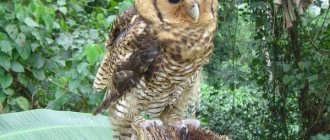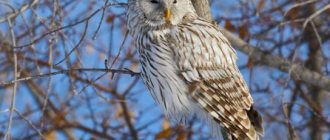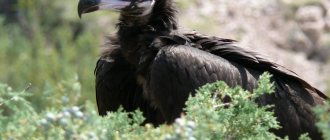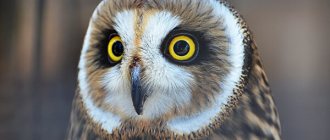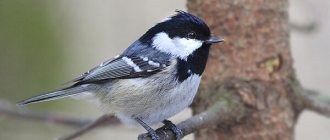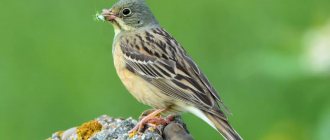Characteristics and description of the bird
Barred Fish
Owls are nocturnal for several reasons:
- The basis of the owl's diet consists of rodents and small mammals, which are also active at night;
- Owls with acute hearing find it easier to find prey at night, when most extraneous sounds are absent;
- small diurnal birds, when they detect an owl, begin to emit calls of danger, scaring away prey and attracting other birds, including larger predators.
The nocturnal bird hunts in two ways: it either ambushes on tree branches, or flies as low as possible above the grass or bushes. Hearing a rustle or squeak of a potential victim, the bird rushes towards the sound and captures the prey with its claws.
Spotted Owl
Owls do not form flocks and live alone or in pairs. Most researchers believe that owls are not migratory birds, since they spend a significant part of their lives in the same territory.
The importance of owls in nature is due to their participation in natural selection: predators exterminate weak and sick animals and birds. Owls also limit the reproduction of rodents, which are field pests.
The population numbers of most species of owls are steadily recovering and do not cause concern. Endangered species listed in the International Red Book include the African masked barn owl, fish eagle owl, forest owl, and Anjouan army owl.
What does it look like
Eared
Owls have a characteristic, easily recognizable appearance:
- all members of the family have large heads, while the plumage of the front part forms the so-called facial disc from dense feathers diverging in different directions;
- the beak is curved down, the base is covered with a cere, surrounded by small hair-like feathers that act as vibrissae;
- the paws are small, the upper part is feathered, the toes end in sharp claws, the fourth toe can turn forward and backward;
- the tail is relatively short, consisting of 12 tail feathers.
The plumage color of most owl species is dull. Usually gray, brown, and brown shades predominate. The color often contains numerous black or light inclusions in the form of spots, dots, and stripes.
How is an owl different from an eagle owl?
Eastern armyworm
The eagle owl and the owl are members of the subfamily of true owls. You can distinguish them from each other by the following characteristics:
- eagle owls are larger than owls;
- eagle owls have so-called feather ears, which are tufts of elongated feathers growing above the eyes;
- in owls, feathers diverging in different directions from the eyes form a corolla;
- the structure of owls' feathers provides them with silent flight; during the flight, the eagle owl makes sounds similar to a whistle;
- owls are active mainly at night, eagle owls hunt at any time of the day.
Keeping owls at home
The desire to have an owl as a pet is constantly reinforced by various films, books and TV series in which these birds appear as mystical, mysterious companions of heroes. However, in reality, keeping these birds at home is quite difficult. This is daily work that requires large investments and dedication.
Poll: Do you think it is possible to keep owls as pets?
No, this is unacceptable, as they are wild predators that do not attach themselves to people.
30.77%
It is impossible, because at home it will not be possible to provide them with the conditions in which they live in the wild.
53.85%
It is possible if you try hard and organize a suitable space.
15.38%
Voted: 13
The process of assimilation of an owl into a new space takes quite a long time. The bird requires a large amount of free space, since in the wild it is accustomed to space and scope.
It is worth equipping at least a separate room for the owl, in which it could fly safely.
To do this, it is necessary to install a strong mesh and curtains on the windows that do not let the bird out of the apartment and do not allow it to be distracted by what is happening outside the window. It is best to attach a structure that imitates branches to the walls. It can be made of iron, but it is better for these purposes to take wood, which will be an easily recognizable object for the owl.
Also, owners who want to keep an owl at home need to pay attention to the following features of its keeping:
- Regular flights are an important part of an owl's daily schedule. For her, this is an opportunity for psychological warm-up and physical activity. Therefore, the bird must be constantly released to fly in specially equipped conditions for this.
- Owls do not tolerate loneliness well. If there is a lack of communication, they may begin to make sharp, shrill sounds for a long time.
- When spending time together with a pet, the owner receives many positive emotions. However, such communication also has problems: birds leave scratches and cuts, even when in a good mood. This is due to the excessively long claws adapted for capturing prey.
- The diet of owls at home is practically no different from the diet of predators in the wild. They need food of animal origin: worms, insects, rodents, snakes, fish. It is important that all food offered is fresh, otherwise the owl will starve. For varieties that came from tropical countries, the use of fruits and berries would be optimal.
When owls start eating, they help themselves to cut up prey with sharp talons and beaks. As a result, all the insides fly in different directions, which can quickly dirty the room. Therefore, the owners of such pets should gut the offered food themselves and only after that offer it to the bird.
Cage maintenance is a separate important point in the extensive section of rules for caring for owls. To keep it clean, it is necessary to treat the cage with special products every week. In addition, the owner of the owl will have to take care of removing feathers during the annual molting. He will also have to refresh the water cup daily, ensuring the bird has access to a clean source of drinking.
Types of owls with photos and names
Scops Owl
The family of true owls of the order Owls includes 30 genera and more than 200 species, 17 of which are found in Russia. Descriptions of the most interesting species of owls are presented below.
Rabbit owl
Also known as the cave owl. Prefers to settle in open areas with low vegetation. It can hunt during daylight hours, with the exception of the midday heat. The rabbit owl is known for collecting mammal excrement and depositing it near its burrows, thereby attracting beetles, which it then eats.
Great Horned Owl
Medium sized owl. It lives in forested regions of Central and South America. A characteristic external feature of the horned owl is its very long feathered ears.
polar owl
One of the largest representatives of the family: the weight of females reaches 3 kg with a body length of 70 cm. The polar owl is common in the arctic and subarctic zones of Eurasia and North America. In summer, snowy owls live in the tundra, and in winter they migrate to the forest-tundra or steppe, which is richer in food.
Barn owl
Due to their habit of settling near agricultural farms and homes, barn owls are also called barn owls. A distinctive feature of the species is the shape of the facial disc, which resembles a heart. The barn owl prefers to live in open forests, meadows with tall grass, near water bodies and swamps.
Hawk owl
The predator, flying quickly low above the ground, is often confused with a hawk. The owl, similar in habits and color to hawks, lives in the coniferous forests of North America, Europe and Asia. Quite large birds often become prey for hawk owls: hazel grouse, partridges, black grouse.
Common eagle owl
The largest representative of the owl order. The large body size allows the eagle owl to hunt waterfowl and chicken birds, hares and other small mammals. On the territory of Russia, the most numerous population is the Siberian subspecies of the eagle owl.
Kinds
There are 2 families of owl-like birds - true owls and barn owls. Many genera of feathered predators inhabit territories from the equator to the northern countries. Some species of owls have become particularly famous.
Long-eared owl. Gray-brown plumage on the upper part of the body with dark spots, the lower part is marked with transverse lines. On the head there are ear tufts of feathers up to 3 cm, which give the bird its name.
The size of the owl is approximately 35 cm in length, with a wingspan of 90 cm. It prefers coniferous forests of European countries and northern Asia, where it nests. Hunts over open places - in fields, along copses. Leads a nocturnal lifestyle. It feeds on mice, small animals, and birds. The long-eared owl spends the winter months in Africa.
Listen to the voice of the long-eared owl
Gray owl. Large bird, body length up to 80 cm. Gray-smoky plumage color. The eyes are bright yellow. Taiga inhabitant. It is also found in the mountainous regions of Europe, in Mongolia. The owl got its name because of the black spot below its beak, similar to a beard. white feathers form a collar on its neck.
Sparrow owl. A small representative of the family, the bird’s body length is only 16-19 cm, weight 60-80 g. The head seems to be slightly flattened. There are rings of white and brown around the yellow eyes, and whitish eyebrows above the eyes.
Small yellowish specks strew the top of the owl's head; there are larger spots on the grey-brown feathers of the back. The abdomen is white with dark longitudinal stripes. The bird settles in spruce forests, hunts day and night, and leads a sedentary life.
Listen to the voice of the pygmy owl
Little owl. Light brown color range of plumage. The eyes are deep-set, as a result of which the bird has a frowning appearance. Round sand spots on the wings, oblong spots on the chest and abdomen.
The bird is common in Southern Altai, Transbaikalia, central Europe, Asian countries, and northern Africa. They prefer steppe areas, desert areas, where there are many rodents and lizards.
Listen to the little owl
Common barn owl. A striking difference of the bird is that the facial disc is heart-shaped. The peculiar appearance is complemented by the asymmetrical arrangement of the ears - the left ear is located along the line of the forehead, and the right one should be looked for in the area of the nostrils. This feature provides the bird with good hearing.
The size of the barn owl is average - body length up to 39 cm, weight 200-500 g. The plumage on the back is bright red, with numerous spots, specks, and stripes. The shades change according to the bird's habitat.
Listen to the voice of a barn owl
White Owl. The bird is an inhabitant of the tundra, so camouflage color is very important for snowy areas. The dark beak, black spots, yellow eyes seem especially bright in the snow-white plumage.
The bird is up to 65 cm long and weighs up to 2.5 kg. They prefer open areas and almost never fly into forest areas. The diet is based on lemmings. The polar owl is listed in the Red Book; a rare species lives in Greenland and North America.
Hawk owl. The size of the bird can be compared to the size of a crow. A remarkable striped color is characteristic of the lower part of the body. The main tone is brown-brown with white spots.
Found in Karelia, Murmansk region, Kamchatka, Asia, North America. The tail is long. The hawk owl is a wintering bird. In the diet of harsh times, hazel grouse and white partridges appear instead of rodents.
Listen to the hawk owl
Scops Owl (common scops owl). The plumage is gray-brown in color with multiple streaks and light transverse stripes. The length of the scops owl is approximately 22 cm, weight 80 g. It lives in mountain forest areas. Migrant. Winters in Africa and southern Asia.
Listen to the voice of Scops Owl
Owl. In the large family of owls, this is the largest representative. On the large head, in the areas of the auditory openings, there are hard feathers similar to auricles. The color of the feathers is fawn, ocher.
Unlike many of their relatives, they hunt large prey during the day - hares, young roe deer, pheasants. Favorite habitats are steppes, where the large wingspan meets no obstacles.
Listen to the voice of an owl
Dimensions
The body length and weight of adults of some varieties of owls are presented below.
| View | Body length, cm | Weight, kg | Wingspan, cm |
| Great Gray Owl | 80 | 2,6 | 160 |
| Common eagle owl | 75 | 3,2 | 190 |
| Barred Fish Owl | 63 | 1,7 | 150 |
| Spectacled neotropical owl | 52 | 1,25 | 130 |
| Spotted Owl | 43 | 0,6 | 115 |
| Long eared owl | 37 | 0,25 | 95 |
| Scops Owl | 20 | 0,13 | 50 |
| Eastern armyworm | 18 | 0,1 | 48 |
How many years do they live
Anjouan Owl
Owls have long been considered a symbol of intelligence and wisdom. In this regard, many people mistakenly believe that these birds are long-lived.
In fact, owls live relatively short lives, and their lifespan directly depends on the species. Thus, the smallest scops owls live up to the age of 5-6 years, owls - up to 8-10 years, larger hawk and long-eared owls - up to 13-15 years, eagle owls and barn owls - up to 18-20 years.
The main reasons for the premature death of birds are attacks by enemies, death due to lack of food in the winter months, and forest fires. An owl living in captivity has a chance to live twice as long as in natural conditions.
Behavior and lifestyle
Recommended by topic
Blackbirds Woodpecker Heron
Despite the centuries-old history of owls living next to people, their way of life is still considered unexplored. Scientists know that predators prefer a sedentary lifestyle, but some species are able to fly from one place to another. In addition, owls prefer to live in pairs, avoiding large flocks.
They can nest in a hollow tree, a rocky ravine, or in underground burrows. Sometimes owls occupy empty, once abandoned nests. They can live freely near a person.
Owl living in a hollow
The ability of owls to live near people gave the birds a bad reputation, since meeting them was considered a dangerous sign. Because of mystical ideas about the reputation of these birds, people tried to drive them away from residential buildings, not allowing them to settle near villages.
At night, owls go out hunting, and during the day they prefer not to come out of their hiding places. At this time, they rest, gaining strength before night activity. During the daytime, owls can only come out of their hiding places when another predator approaches and is about to attack their home.
The exception to the time cycles of activity are snowy owls. Their activity level does not depend on the time of day, which is due to the characteristics of the region of residence.
Question to the expert
Do owls see well during the day?
Despite the fact that owls are considered nocturnal predators, they see quite well during the day. An owl has many other reasons for being active at night, unrelated to vision. The only problem with their visual apparatus can be called some myopia, which does not allow owls to see objects directly next to them.
Diet of owls
Due to the fact that owls live almost everywhere, their diet is very diverse. However, the determining role in its composition is played by the fact that these birds belong to predators, and therefore their diet consists mainly of warm-blooded animals:
- Rat.
- Vole.
- Rabbits.
- Zaitsev.
- Khomyakov.
Polar owls are able to feed on fish, partridges and geese.
However, some species, for example, those that belong to the “Needlepods,” eat insects such as hawk moths or moths. Barn owls and barn owls may feed on rodents and other pests. For this property, the presence of owls is valued by people near whom the birds settle.
Owls are able to remain without water for a long time, since water balance is maintained through the supply of fresh blood secreted by the prey they eat.
In winter, predators make a preliminary supply, leaving mouse carcasses in nests. Hunting during this period takes place mainly on forest edges and clearings.
Owls will never eat carrion. The prey must be fresh or taken from previously made stocks. In the absence of suitable options, the birds will starve until they find suitable food.
Where do they live?
Spectacled nontropical
Owls have a wide range of habitats. Various species of owls are found on all continents and in all climatic zones. The exception is Antarctica and some oceanic islands.
Where live
The typical habitat of most owls is lowland and mountain forests. Some species are found in steppes, semi-deserts, tundra and other natural areas with a predominance of open terrain. Owls also settle near populated areas and can build nests in the attics of houses and under the roofs of outbuildings.
Lifestyle and habitat
Owls are distributed everywhere - they can be found on the seashore, in the desert, in mountainous areas, among steppes, and forests. The only place you can't find owls is in Antarctica. Russia is home to 18 species of owl birds. In addition to wild nature, predators stay in the suburbs, not far from human habitation.
In the attics of buildings, under the roofs of houses, you can find that an owl lives there. What kind of bird, migratory or not , becomes clear from its behavior with the arrival of cold weather. Not all species of owls fly to the southern regions; most are sedentary. Migrations are caused only by an acute shortage of food. Mountain birds migrate to the plains, northern owls leave their nesting sites before the weather warms up.
Wooded areas attract birds more, but there are species associated with open areas. Bird nests can be found in abandoned hollows, among rock crevices; polar owls lay eggs simply in a hole.
The owl is a nocturnal bird , but white hawks, hawks, and little owls also hunt during the daytime. Excellent eyesight, keen hearing, and the ability to fly silently make birds unrivaled hunters. In search of prey, they sometimes emit sharp screams that scare away rodents. The slightest movement serves as a signal to the predator to attack.
You can determine the type of bird by its voice and characteristic sounds:
- The eagle owl makes a “laugh”;
- “yelping, coughing” are characteristic of the long-eared owl and tawny owl;
- a monosyllabic hoot is reproduced by a polar owl;
- a monotonous whistle comes from the sparrow owl, scops owl.
Owls lead a solitary lifestyle and do not form flocks. Isolated existence is associated with attachment to a specific area, individual territory.
What do they eat?
Owls are predators. The diet depends on the size of the bird. Small species eat insects, lizards, frogs, mice and other small rodents. Large owls can hunt rats, shrews, snakes, hares, as well as birds, including domestic ones. Species such as the tawny fish owl and fish owl feed primarily on fish.
In winter, owls living in northern and temperate latitudes have significantly less prey. Predators feed on rodents and small birds that do not make seasonal migrations.
Legend bird
In folklore, especially in the Middle Ages, owls were surrounded with a mystical aura, whole legends were written around them, in which owls were credited with supernatural abilities. Therefore, in real life they were bypassed and experienced, at times, outright fear.
This is most likely simply due to the fact that the owl is a predator. Moreover, a predator that leads the most active part of its life at night, simply by its nature, in fact, brings many benefits to humanity by keeping the number of small rodents under control.Now this bird is more perceived as a symbol of wisdom.
How do they reproduce?
The main mating season for owls is in the spring, but with an abundance of food and favorable weather conditions, they can re-lay eggs and hatch chicks. Owls are characterized by the formation of monogamous pairs, with the male remaining with the female even after the end of the breeding season, taking part in raising the offspring.
Owls do not build nests, but prefer to arrange shelter in hollows, openings between stones, and crevices. Birds that live near human settlements nest under roofs and in attics.
The female lays from 3-4 to 10 eggs. The incubation period lasts about a month, during which time the male actively hunts, providing food for his mate. The chicks that are born are covered with down, their eyes and ear openings are closed. By 2 months, the owlets begin to fly. By this time, the down is replaced by feathers.
Great Gray Owl
Since the chicks hatch one after another, by the time the last chick appears, the first ones have already grown noticeably and eat almost all the prey brought by their parents. Often the last to hatch chicks die of starvation, unable to compete with their larger older brothers and sisters.
CUCKOO
Reproduction and offspring
Owls rarely build nests; they mainly try to find a convenient hollow, old nesting sites of large birds, or a crevice in the rocks. Tawny owls can live in artificially created houses. Little owls love to live near human habitation: in attics and barn roofs. Owls of different species can produce offspring from 1 to 3 times a year. This factor also depends on the amount of food. Some of them form pairs for life, others - for one season.
The female lays eggs on the surface of the nest without any bedding. The clutch may contain 3-10 white spherical eggs. If the chicks do not have enough food, the older and stronger owlets may eat the smaller or weaker ones. If there is enough food, then chicks of different age groups can coexist normally in the nest. The females do the incubation, and the chicks are fed by both parents. Father and mother bring food to all the owlets, but pay more attention to the oldest ones.
Owl chicks covered with down
Young owls mainly die due to a lack of food supply. In some periods there is a shortage of rodents, hares and other small animals. In “hungry” years, up to 28% of chicks can die. Sometimes owlets themselves fall out of the nest or fly out prematurely. Then they often become prey for foxes, raccoons and ferrets. Parents continue to feed the chicks even after leaving the nest.
When danger appears, the adults notify the chicks with a signal. The owls, in turn, stop making noise and try not to move. When young animals quarrel or fight, a loud, dissatisfied squeal and squeak is heard.
Who eats owls
The natural enemies of adult owls in nature are larger birds of prey: hawks, eagles, golden eagles. Owl nests located in hollows can be devastated by ferrets, martens and other predators from the mustelid family.
Frail owlets that fall out of the nest become prey for foxes, raccoons, arctic foxes, and skuas.
EAGLE
Habitat - where owls live
Habitat of the snowy owl
Different species of owls live all over the planet, with the exception of Antarctica. They are found in Europe, Asia, America, Australia and other lands. The bird lives in mountainous areas, steppes, deserts, near water bodies, and can also be found in populated areas.
Since during the hunt, owls try to watch for prey and create the effect of surprise, they rarely live in open areas. They require that occupied lands must have trees, large stones and other objects behind which they can hide while waiting for prey.
To build a nest, the bird chooses a hard-to-reach place where larger predators will not find it. Preference is given to crevices and tree hollows. There have been cases when owls huddle in the attics of abandoned buildings. They are also capable of occupying the nests of other birds, driving out the previous inhabitants.
How do they sleep
In nature, owls sleep in hollows or in secluded places among tree branches, clinging to them with their talons. Poultry lies on the bottom of the cage or on the bedding with its belly down and legs extended.
Breeding in captivity
If desired, the owner of a pair of owls can start breeding this interesting bird. Often such activities turn into quite profitable businesses. You need to start breeding by creating a comfortable nest. It can be made from a log with a hollow or from a cabinet with a cut hole. At the bottom of the hollow, a bedding is made of fluff, dry grass and feathers. The owl does not lay eggs all at once, but at intervals, so after all the chicks hatch, they will be of different ages. Newly hatched chicks need to be given more attention and their health monitored. After a month, the juveniles will try to fly.
It is better to give the chicks to a new owner at the age of two months. But before that, the owlet needs to become tame. To do this, wear thick gloves so that the bird does not injure your hands with sharp claws, and take the owlet in your hands. This must be done carefully so as not to scare the chick. In this case, it is advisable to talk to him in a quiet, gentle voice, showing that you are friendly. Experienced breeders recommend starting taming owlets at two weeks of age. When the time comes to give the baby away, he will already be completely tame.
How many degrees does an owl's head turn?
In owls, unlike other birds, the eyes are located not on the sides of the head, but in front. The eyeballs are elongated and held in the skull by bony sclerotic rings. Due to this structural feature, the eyes hardly move, so owls have a narrow field of vision. In order to look around or follow moving prey, they are forced to turn their heads.
An owl can turn its head 135 degrees to the right or left from its original position, for a total head rotation of 270 degrees. The amazing mobility of the neck is ensured by the special structure of the skeleton: the owl has a larger number of vertebrae (there are not 7, like other birds, but 14). The cervical spine also contains additional vessels that supply blood to the brain when the head turns sharply.
PENGUIN
Diet
To understand what an owl eats, you just need to remember once again that an owl is a bird of prey. In addition to the already mentioned small rodents, the obligatory menu of owls includes snakes, lizards, and worms.
If habitat permits, some species hunt fish in shallow waters. Large specimens even gobble up hedgehogs, pheasants and black grouse.
- Winter birds | Wintering birds
Pigeon - types and differences, features, flight, nutrition and reproduction + 88 photos
- Cormorant - how to recognize where it occurs, reproduction, appetites + 103 photos
Interesting facts about owls
Peruvian pygmy owl
- The type of owl can be determined not only by its appearance, but also by the nature of the sounds it makes. Thus, the eagle owl screams loudly and intermittently, as if laughing, tawny owls “cough”, most species of owls emit a monosyllabic hoot. Noctuid owls and small owls have the quietest voices: their calls are similar to whistling.
- Owl eggs are always painted white and have an almost regular round shape.
- Owls have good night vision, but hearing plays a major role in orienting in the dark. Features of the auditory system of nocturnal predators include the presence of external ears formed by plumage, dilated auditory canals, and an outwardly curved eardrum. An owl's ears, which are large holes, are positioned asymmetrically: the left ear is usually higher than the right.
- Owls are the main characters of the world-famous series of books by writer Katherine Lasky "Night Watchmen". Despite the fantasy genre, the books contain reliable information about the lifestyle of birds and their habits. The action takes place in the distant future after people have disappeared. Owls are represented as intelligent beings: they communicate with each other, read and write, create works of art, have a parliament and fight evil on the planet.
- The smallest owl in the world is the Peruvian pygmy owl. It belongs to the genus of pygmy owls and weighs only 30 grams with a body length of 15 cm.
Origin
It is believed that the first owls appeared approximately 65 million years ago, during the Eocene period. However, the remains found indicate that their appearance was far from modern. The species of this bird that lived during that period of time are classified into separate genera: Eostrix, Strigogyps and others. They are now considered extinct. Modern owls evolved about a million years ago.
Their hunting method significantly influenced their evolution.
Owls stand motionless, listening to the slightest rustles. They are able to accurately determine the position of the target and the distance to it. Having prepared itself, the predator takes off and grabs the prey with its claws. This is why owls switched to a nocturnal lifestyle, since it is easier to maintain the element of surprise. In the future, this was reflected in the appearance and characteristics of the body. Interesting fact : some species of owls can hunt during daylight hours. For example, these include individuals living in the Arctic, where the polar day can last more than 24 hours.

